Opinion: We need women designing buildings – CNN.com
We Need to Prize Talent, not Self-Promotion
by Dr. Mark David Major, AICP, CNU-A, The Outlaw Urbanist contributor
Denise Scott Brown should (have) be(en) recognized with Robert Venturi for the 1991 Pritzker Prize. However, the ongoing debate on this subject is frustrating. It is frustrating because the ideal of gender equality expounded for the architectural profession – and, by implication, other professions – too often relies on arguments that are, at best, manifestly superficial and, at worse, reinforce the gender stereotypes underlying the problem.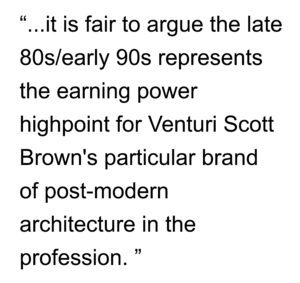
This particular debate has not been helped by public comments (perhaps taken of out context) by both Robert Venturi and Denise Scott-Brown that do not ‘hold water’ in explaining why she was not recognized with Venturi for the Pritzker Prize in the first place. For example, in the above CNN article, Scott Brown is quoted as saying””we could not afford to pass up the Pritzker Prize for the sake of our fledgling firm.” It seems far-fetched to describe Venturi Scott Brown and Associates as a “fledgling firm” in 1991. A Wikipedia listing of their selected works identifies four major projects in 1991, more than any other year listed over a 44-year period (Source: Wikipedia). Quite the opposite, in fact, since it is fair to argue the late 80s/early 90s represents the earning power highpoint for Venturi Scott Brown’s particular brand of post-modern architecture in the profession. Venturi and Scott Brown’s public comments suggest they are protecting somebody for the initial oversight, either Venturi himself or The Hyatt Foundation, which organizes and awards the Pritzker Prize.
However, this is a side issue to larger problems: namely, the promotion of talent, in general, and insidious effects of gender discrimination, in particular, in the architectural profession. Marika Shioiri-Clark and John Cary’s CNN opinion piece manages to negatively typify these problems at a gross level while still being right in some of its details. First, we do not need “women designing buildings.” This is the same superficial argument we have heard from feminists for decades; namely, if we only elected women to political leadership we would have world peace. Female political leaders have proven time and time again over the last 40 years that equality has nothing to do with their gender and everything to do with how women can be equally inspirational, vicious, divisive and (in)competent as their male counterparts. Instead, what we need are talented people (women and men) designing buildings. We should have zero interest in promoting mediocre architects, regardless of their gender.
 As Shioiri-Clark and Cary correctly point out, female architectural students regularly outperform their male counterparts in school, substantially so in our experience. If the profession truly prized and promoted talent, female architects would naturally rise to the top because there lies the talent (sorry, male architects but it is true). However, the profession is still trapped within the grips of the (often self-manufactured) ‘myth of architectural genius’. This practice prizes the architect’s ability to self-promote and network that myth in the profession, popular media, and books. In doing so, the superficial is valued over the substantive in architecture (very post-modern, indeed). Unfortunately, the profession’s manifest failure to promote talent also sweeps women architects out of the limelight as a result. Once you get pass the names Zaha Hadid, Denise Scott Brown and Elizabeth Plater-Zyberk, it’s damn difficult to name any superstar women architects. It’s even worse for planners (Jane Jacobs was an economist, so don’t even try it). However, “The fault, dear Brutus, is not in our stars, But in ourselves.” Our vision is my-opic (literally and metaphorically).
As Shioiri-Clark and Cary correctly point out, female architectural students regularly outperform their male counterparts in school, substantially so in our experience. If the profession truly prized and promoted talent, female architects would naturally rise to the top because there lies the talent (sorry, male architects but it is true). However, the profession is still trapped within the grips of the (often self-manufactured) ‘myth of architectural genius’. This practice prizes the architect’s ability to self-promote and network that myth in the profession, popular media, and books. In doing so, the superficial is valued over the substantive in architecture (very post-modern, indeed). Unfortunately, the profession’s manifest failure to promote talent also sweeps women architects out of the limelight as a result. Once you get pass the names Zaha Hadid, Denise Scott Brown and Elizabeth Plater-Zyberk, it’s damn difficult to name any superstar women architects. It’s even worse for planners (Jane Jacobs was an economist, so don’t even try it). However, “The fault, dear Brutus, is not in our stars, But in ourselves.” Our vision is my-opic (literally and metaphorically).
Shioiri-Clark and Cary also correctly call out the Architectural Registration Exam (ARE) process for institutionalizing discriminatory practices against women but then incorrectly name the reason (i.e. financial). The real discriminatory practice against women associated with the ARE lies in the limit to a 6-month reporting period for the Intern Development Program (IDP). When a woman temporarily leaves the workforce to bear a child, the typical disruption to her career is much longer than 6 months. Sure, there are some ‘super’ women out there in the profession, for whom this is not the case. They may work until 4-6 weeks before giving birth and return to work 3-4 weeks afterwards. But, more typically, the disruption to a woman’s career extends over a two-year period from the early decision-making stages of pregnancy to the early childhood-raising stages after birth. Let’s be honest, given the supreme and unchallenged role that mothers play in raising their children (especially compared to fathers), the real disruption is 18 years… or even a lifetime. In any case, the one thing the profession could do today to promote gender equality and enable more women to become registered architects is extend the reporting period for IDP to two years.
In their opinion piece, Shioiri-Clark and Cary then transition to the visibility of women architects in the profession. If we focus the question on the promotion of talent instead of valuing the promotion of self, then this is the same problem, i.e. the crème will rise to the top if we value talent.

At this point, the Shioiri-Clark and Cary article takes a mind-bogglingly bizarre turn to discuss “Architect Barbie”, which manages to be both comical and hypocritical, thereby undercutting every point they are trying to make in the article. Perhaps it’s true that Shioiri-Clark and Cary only do this to spark controversy and drive visitor hits on the article. However, when it comes to the larger question of gender discrimination, it’s hard to get more inconsequential than discussing dolls within the context of a serious subject.
Shioiri-Clark and Cary close the article by further expounding further on the ‘world would be a better place if it was run by women’ argument/fallacy. It would not be any different except women would more equally share in the blame for our problems as well as the praise when those problems are solved. 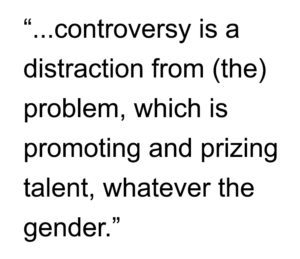 That is true equality. So give Denise Scott Brown her share of the 1991 Pritzker Prize but women and men should not make the mistake of thinking it addresses the real problem in the profession. At this point, the Pritzker Prize controversy is a distraction from that problem, which is promoting and prizing talent, whatever the gender. If the playing field was level in this regard, there is little doubt women would rise en masse to the top of the profession… and our built environment would, indeed, be better served.
That is true equality. So give Denise Scott Brown her share of the 1991 Pritzker Prize but women and men should not make the mistake of thinking it addresses the real problem in the profession. At this point, the Pritzker Prize controversy is a distraction from that problem, which is promoting and prizing talent, whatever the gender. If the playing field was level in this regard, there is little doubt women would rise en masse to the top of the profession… and our built environment would, indeed, be better served.
Read the full CNN.com article here: Opinion | We need women designing buildings – CNN.com

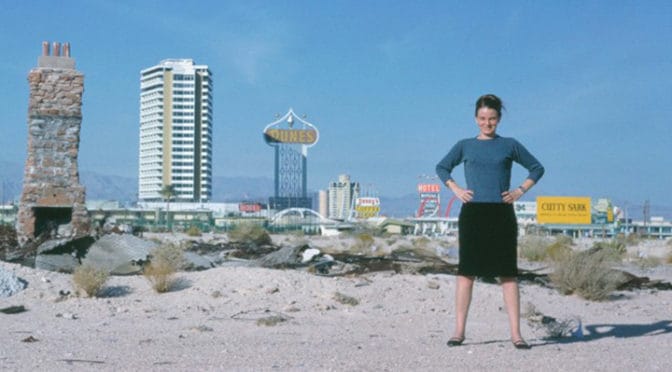
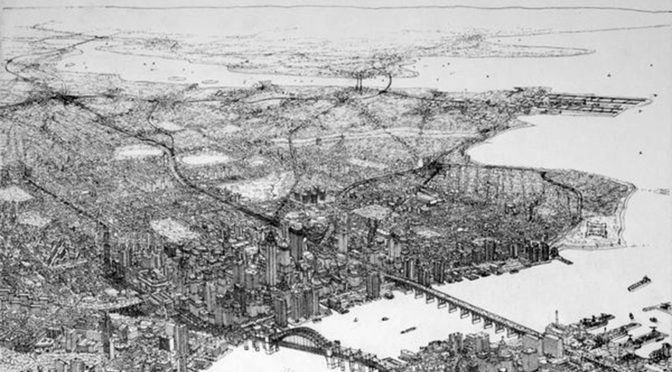
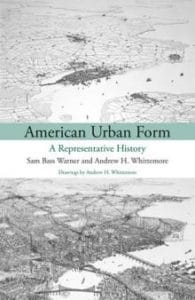
 We have to believe this word choice is intentional. In this sense, American Urban Form comfortably sits within the prevailing planning paradigm of the post-war period in the United States (see M. Christine Boyer’s Dreaming the Rational City: The Myth of American City Planning for an excellent and detailed discussion on this topic). Unfortunately, it is also consistent with a recent, unfortunate trend in planning theory to claim to discuss one thing (physical form and space) but substantively reinforce prevailing thought (an a-spatial perspective of the city). Even when American Urban Form does discuss the physical fabric of ‘the City’, it tends to become trapped in discussing architectural styles.
We have to believe this word choice is intentional. In this sense, American Urban Form comfortably sits within the prevailing planning paradigm of the post-war period in the United States (see M. Christine Boyer’s Dreaming the Rational City: The Myth of American City Planning for an excellent and detailed discussion on this topic). Unfortunately, it is also consistent with a recent, unfortunate trend in planning theory to claim to discuss one thing (physical form and space) but substantively reinforce prevailing thought (an a-spatial perspective of the city). Even when American Urban Form does discuss the physical fabric of ‘the City’, it tends to become trapped in discussing architectural styles.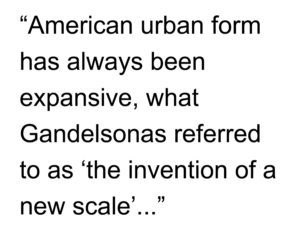 Namely, American urban form has always been expansive, what Gandelsonas referred to as “the invention of a new scale”, especially in comparison to European models of urbanism. If the authors had taken different cities as their subject (such as Chicago, St. Louis, and New Orleans), then a different (and, perhaps, more common) picture might have emerged in their narrative about the physical form of the American city.
Namely, American urban form has always been expansive, what Gandelsonas referred to as “the invention of a new scale”, especially in comparison to European models of urbanism. If the authors had taken different cities as their subject (such as Chicago, St. Louis, and New Orleans), then a different (and, perhaps, more common) picture might have emerged in their narrative about the physical form of the American city.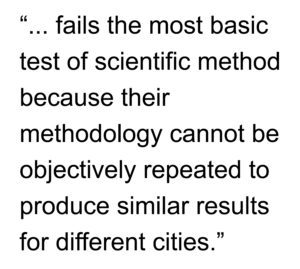 In itself, this is revealing since roughly half of the book is devoted to the first 200 years of ‘the City’ whereas the second half covers approximately the last 115 years. This is unfortunate since important aspects of early urban form are casually mentioned and their generative effects are not explored in detail. Instead, the narrative quickly returns to surer ground. i.e. a pseudo-history of political, social, and economic factors.
In itself, this is revealing since roughly half of the book is devoted to the first 200 years of ‘the City’ whereas the second half covers approximately the last 115 years. This is unfortunate since important aspects of early urban form are casually mentioned and their generative effects are not explored in detail. Instead, the narrative quickly returns to surer ground. i.e. a pseudo-history of political, social, and economic factors.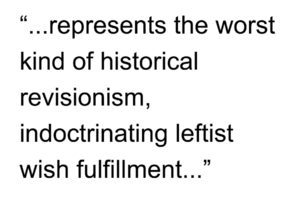 Much like Whittemore’s detailed and pretty bird’s eye views of ‘the City’ in the book (for the most part, vacant of meaning because they are a fiction, too; the one clear-cut exception is his wonderful aerial perspective of ‘dumbbell tenements’ on page 71), American Urban Form remains trapped in a single perspective on its subject. It either ignores, consigns to happenstance, or weaves an elaborate explanation for anything that might contradict or interrupt that perspective. Collectively, the result is a fanciful city of leftist, pseudo-Marxist fallacies. If you are already a member of the choir, you will like American Urban Form: A Representative History because you know the song and can sing along. If not, you will be better served by reading the history of a real city, examining in detail its historical plans and bird’s eye view drawings, and making your own conclusions.
Much like Whittemore’s detailed and pretty bird’s eye views of ‘the City’ in the book (for the most part, vacant of meaning because they are a fiction, too; the one clear-cut exception is his wonderful aerial perspective of ‘dumbbell tenements’ on page 71), American Urban Form remains trapped in a single perspective on its subject. It either ignores, consigns to happenstance, or weaves an elaborate explanation for anything that might contradict or interrupt that perspective. Collectively, the result is a fanciful city of leftist, pseudo-Marxist fallacies. If you are already a member of the choir, you will like American Urban Form: A Representative History because you know the song and can sing along. If not, you will be better served by reading the history of a real city, examining in detail its historical plans and bird’s eye view drawings, and making your own conclusions.
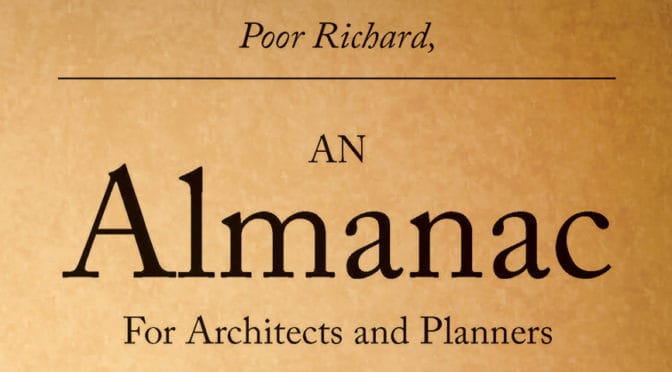
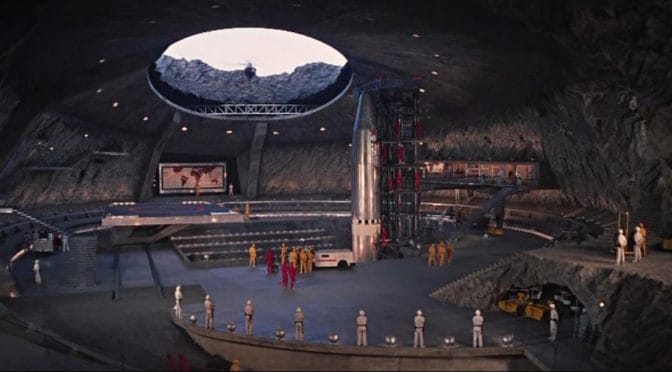
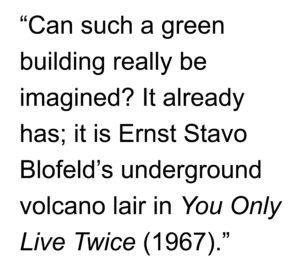 It can only be found in exurban locations, i.e. near to an urban location but not too close. Somehow, it reconciles an inherently contradictory nature into its very function. In short, this magnificent green building is all things to all people.
It can only be found in exurban locations, i.e. near to an urban location but not too close. Somehow, it reconciles an inherently contradictory nature into its very function. In short, this magnificent green building is all things to all people.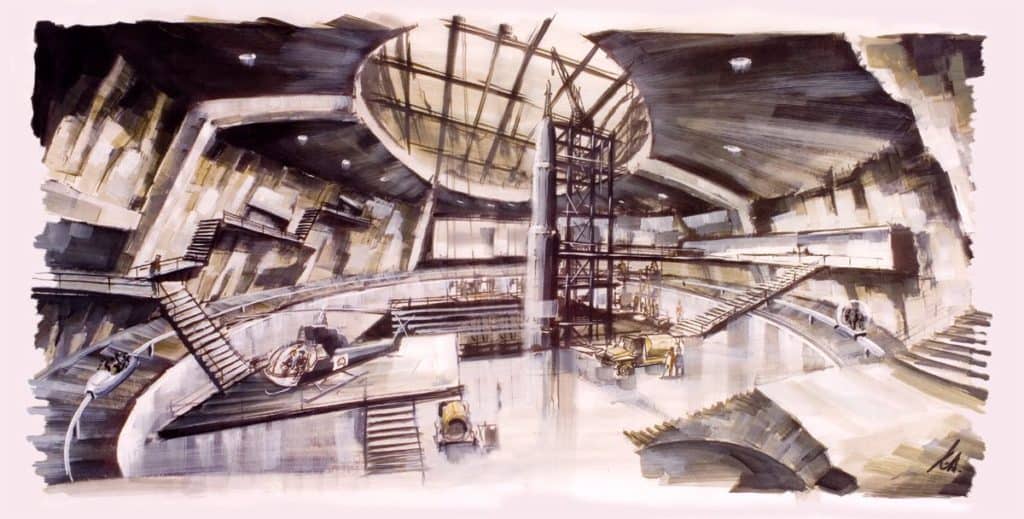

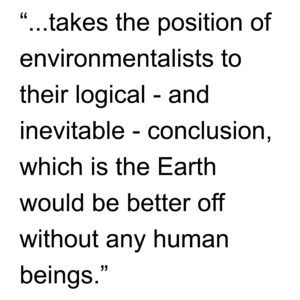 In the follow-up film, Moonraker (1979), the villain Hugo Drax explicitly engages in large-scale eco-terrorism by hatching a scheme to release a viral toxin on the Earth, which will destroy all human life but leave unharmed all other plant and animal life. Drax takes the position of environmentalists to their logical – and inevitable – conclusion, which is the Earth would be better off without any human beings. Drax attempts to implement his dastardly plan while safely secluded in his moon base lair (also Michael Myers’ satirical inspiration for Dr. Evil’s moon base lair in Austin Powers: The Spy Who Shagged Me). Finally, the Bond villain in The Man with the Golden Gun (1974), Francisco Scaramanga, uses solar power for energy at his small-scale lair (in comparison to the Blofeld, Stromberg, and Drax hideouts) on an island in the South China Sea.
In the follow-up film, Moonraker (1979), the villain Hugo Drax explicitly engages in large-scale eco-terrorism by hatching a scheme to release a viral toxin on the Earth, which will destroy all human life but leave unharmed all other plant and animal life. Drax takes the position of environmentalists to their logical – and inevitable – conclusion, which is the Earth would be better off without any human beings. Drax attempts to implement his dastardly plan while safely secluded in his moon base lair (also Michael Myers’ satirical inspiration for Dr. Evil’s moon base lair in Austin Powers: The Spy Who Shagged Me). Finally, the Bond villain in The Man with the Golden Gun (1974), Francisco Scaramanga, uses solar power for energy at his small-scale lair (in comparison to the Blofeld, Stromberg, and Drax hideouts) on an island in the South China Sea.


 Instead of taking action to cut down the perilously hanging tree limb in this grocery store parking lot, someone thought a more effective measure would be to place shopping carts in a circle around the probable landing zone with cautionary tape wrapped about the carts and wait for gravity to do all the work. This is how we solve problems in today’s America. We wait for gravity to pile on instead of taking action to solve the problem. It’s an insane world!
Instead of taking action to cut down the perilously hanging tree limb in this grocery store parking lot, someone thought a more effective measure would be to place shopping carts in a circle around the probable landing zone with cautionary tape wrapped about the carts and wait for gravity to do all the work. This is how we solve problems in today’s America. We wait for gravity to pile on instead of taking action to solve the problem. It’s an insane world!